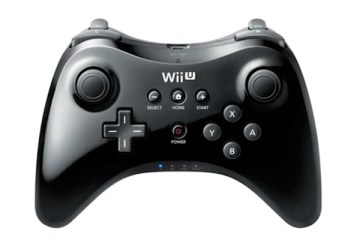Is it better to go first or last? Kick or receive? It’s like the coin toss at a football game, but what if you could do both?
Nintendo just showed us how, surprise-announcing a pre-E3 conference and preempting Microsoft and Sony by snagging mass-media coverage of its upcoming Wii U console, as company president Satoru Iwata trotted out new details about the system, its control interface and an intrepid social networking angle.
Mr. Iwata, framed by nothing more than beige wooden walls and an enigmatic sign bearing Japanese characters meaning “creating something unique,” bowed, then explained that the company’s goal over the past several years has been to figure out how to address an issue with the way we currently interact online. Iwata then did something you don’t often see in presentations like this — he highlighted M.I.T. professor Sherry Turkle‘s Alone Together: Why We Expect More from Technology and Less from Each Other, a book published in January 2011 that explores the ups and downs of the contemporary tech zeitgeist. Nintendo’s response: to create something that would “unite people rather than divide them … whether in the same room or great distances apart.”
(MORE: Coming on Tuesday: Live Coverage of Nintendo’s Wii U Launch at E3)
Enter the Wii U GamePad (the gamepad’s official, if prosaic, name), essentially the same as the prototype shown at E3 2011, only with both the thumbsticks raised, as depicted in recent leaked shots. Other revised features include: the thumbsticks can be clicked (a feature cribbed from Microsoft and Sony), there’s an NFC reader/writer on the left side (place cards or figures and they’ll be wirelessly “read”), the “TV” button turns the gamepad into a universal remote, the backside of the gamepad includes slightly raised ergonomic grips and both the d-pad and face buttons have been moved inward slightly — the d-pad to the right of the left thumbstick, the face buttons to the left of the right thumbstick.
The d-pad move makes sense, given contemporary controller design, but the face button positioning is a surprise. Look at your Xbox 360 controller, for instance, and you’ll notice the the face buttons are placed at far right, with the right thumbstick left and below them. Extend your thumb over the right thumbstick and notice how it’s more difficult to press down or hammer rapidly, but that it’s fine for basic 360-degree analog stick control. It’s much easier to hammer the face buttons when they’re further to the right, since your thumb curls slightly at the joints and has better extensibility and downward torque. It’ll be interesting to see how reversing this feels on the actual Wii U GamePad, and whether it changes the way games for the system are designed.
Iwata also highlighted the way the new gamepad could interact with older Wii-style peripherals, depicting someone swinging a Wii Remote like a golf club while using the Wii U GamePad as the tee. But the other intriguing angle involves something Iwata called “symmetric diversity,” i.e. the fancy-schmantzy way of pointing out that the Wii U Gamepad can interrelate to the TV screen the same way the bottom screen on a DS or 3DS complements the top one (as I’ve said before, the Wii U is basically a living-room-sized DS). What does that mean for games? Iwata says we’ll see this revealed throughout the week at E3, but imagine cleaving a DS in two and fixing the position of one of the screens — I’d wager money the Wii U began life as a pitch to combine the Wii and DS.

Nintendo / YouTube
Much of the presentation’s remainder involved summarizing details that were revealed at E3 a year ago, so I’ll skip to the other noteworthy reveals. There’s the Wii U Pro Controller, which drops the touchscreen and — save for the flipped face button/right thumbstick placement — looks almost identical to the Xbox 360 gamepad. Iwata describes it as “lighter” and says it “may be more attractive for longer, more intense forms of gaming.”
And then there’s something Iwata introduced as “Mii Wara Wara,” the company’s in-house way of referring to the “noise and commotion” created by a crowd of Miis (Nintendo’s virtual representation of players, launched with the Wii). As on the Wii, your Mii as well as those created by others on the system will congregate in a plaza-style area. But unlike the Wii, this now can include friends (from other Wii Us) as well as anyone in your country playing the same game(s) you are.
Iwata called this the “Miiverse,” something that’s “as native to Wii U as the Wii U GamePad.” Translation: Nintendo is doubling down on social networking, and even though it’s at least six years behind Microsoft and Sony building out a comprehensive gaming network, it hopes to bring something new to the table in terms of how other players are represented and interact with each other. In addition to controller-style texting, for instance, Iwata says the Wii U GamePad’s touchscreen — Iwata dubbed it a “social window” — offers enhanced ways to interact with other players (e.g. simpler typing, easier interface navigation, handwritten notes, doodles, etc.).
How important is Miiverse to Nintendo going in? Arguably the most important feature — Iwata said it’s the first thing you’ll see after powering up the system.
[youtube=http://www.youtube.com/watch?v=otXi3ucnlas]

